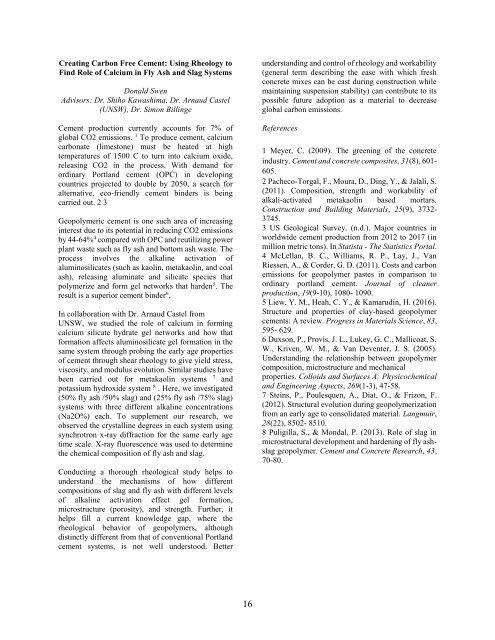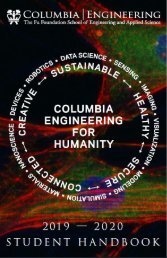Senior Design Expo 2019
The Senior Design Expo, held annually in May at Columbia University, is an opportunity for Columbia Engineering students to showcase what they have learned in their foundational math and science courses together with their engineering courses in innovative, creative, and purposeful designs and prototypes. Each year the Expo showcases more than 60 projects across all nine departments. Projects have included cutting-edge robotics, the New York City subway system, language technology, proposals for bridges to span the Hudson river, and much more.
The Senior Design Expo, held annually in May at Columbia University, is an opportunity for Columbia Engineering students to showcase what they have learned in their foundational math and science courses together with their engineering courses in innovative, creative, and purposeful designs and prototypes. Each year the Expo showcases more than 60 projects across all nine departments. Projects have included cutting-edge robotics, the New York City subway system, language technology, proposals for bridges to span the Hudson river, and much more.
You also want an ePaper? Increase the reach of your titles
YUMPU automatically turns print PDFs into web optimized ePapers that Google loves.
Creating Carbon Free Cement: Using Rheology to<br />
Find Role of Calcium in Fly Ash and Slag Systems<br />
Donald Swen<br />
Advisors: Dr. Shiho Kawashima, Dr. Arnaud Castel<br />
(UNSW), Dr. Simon Billinge<br />
Cement production currently accounts for 7% of<br />
global CO2 emissions. 1 To produce cement, calcium<br />
carbonate (limestone) must be heated at high<br />
temperatures of 1500 C to turn into calcium oxide,<br />
releasing CO2 in the process. With demand for<br />
ordinary Portland cement (OPC) in developing<br />
countries projected to double by 2050, a search for<br />
alternative, eco-friendly cement binders is being<br />
carried out. 2 3<br />
Geopolymeric cement is one such area of increasing<br />
interest due to its potential in reducing CO2 emissions<br />
by 44-64% 4 compared with OPC and reutilizing power<br />
plant waste such as fly ash and bottom ash waste. The<br />
process involves the alkaline activation of<br />
aluminosilicates (such as kaolin, metakaolin, and coal<br />
ash), releasing aluminate and silicate species that<br />
polymerize and form gel networks that harden 5 . The<br />
result is a superior cement binder 6 .<br />
In collaboration with Dr. Arnaud Castel from<br />
UNSW, we studied the role of calcium in forming<br />
calcium silicate hydrate gel networks and how that<br />
formation affects aluminosilicate gel formation in the<br />
same system through probing the early age properties<br />
of cement through shear rheology to give yield stress,<br />
viscosity, and modulus evolution. Similar studies have<br />
been carried out for metakaolin systems<br />
7<br />
and<br />
potassium hydroxide system 8 . Here, we investigated<br />
(50% fly ash /50% slag) and (25% fly ash /75% slag)<br />
systems with three different alkaline concentrations<br />
(Na2O%) each. To supplement our research, we<br />
observed the crystalline degrees in each system using<br />
synchrotron x-ray diffraction for the same early age<br />
time scale. X-ray fluorescence was used to determine<br />
the chemical composition of fly ash and slag.<br />
Conducting a thorough rheological study helps to<br />
understand the mechanisms of how different<br />
compositions of slag and fly ash with different levels<br />
of alkaline activation effect gel formation,<br />
microstructure (porosity), and strength. Further, it<br />
helps fill a current knowledge gap, where the<br />
rheological behavior of geopolymers, although<br />
distinctly different from that of conventional Portland<br />
cement systems, is not well understood. Better<br />
understanding and control of rheology and workability<br />
(general term describing the ease with which fresh<br />
concrete mixes can be cast during construction while<br />
maintaining suspension stability) can contribute to its<br />
possible future adoption as a material to decrease<br />
global carbon emissions.<br />
References<br />
1 Meyer, C. (2009). The greening of the concrete<br />
industry. Cement and concrete composites, 31(8), 601-<br />
605.<br />
2 Pacheco-Torgal, F., Moura, D., Ding, Y., & Jalali, S.<br />
(2011). Composition, strength and workability of<br />
alkali-activated metakaolin based mortars.<br />
Construction and Building Materials, 25(9), 3732-<br />
3745.<br />
3 US Geological Survey. (n.d.). Major countries in<br />
worldwide cement production from 2012 to 2017 (in<br />
million metric tons). In Statista - The Statistics Portal.<br />
4 McLellan, B. C., Williams, R. P., Lay, J., Van<br />
Riessen, A., & Corder, G. D. (2011). Costs and carbon<br />
emissions for geopolymer pastes in comparison to<br />
ordinary portland cement. Journal of cleaner<br />
production, 19(9-10), 1080- 1090.<br />
5 Liew, Y. M., Heah, C. Y., & Kamarudin, H. (2016).<br />
Structure and properties of clay-based geopolymer<br />
cements: A review. Progress in Materials Science, 83,<br />
595- 629.<br />
6 Duxson, P., Provis, J. L., Lukey, G. C., Mallicoat, S.<br />
W., Kriven, W. M., & Van Deventer, J. S. (2005).<br />
Understanding the relationship between geopolymer<br />
composition, microstructure and mechanical<br />
properties. Colloids and Surfaces A: Physicochemical<br />
and Engineering Aspects, 269(1-3), 47-58.<br />
7 Steins, P., Poulesquen, A., Diat, O., & Frizon, F.<br />
(2012). Structural evolution during geopolymerization<br />
from an early age to consolidated material. Langmuir,<br />
28(22), 8502- 8510.<br />
8 Puligilla, S., & Mondal, P. (2013). Role of slag in<br />
microstructural development and hardening of fly ashslag<br />
geopolymer. Cement and Concrete Research, 43,<br />
70-80.<br />
16








